Coalition Operations Demand Technology Solutions
Rear Adm. (Sel.) Craig E. Bone, USCG, chief of staff, 14th Coast Guard District, elaborates on the diverse challenges facing his service.Rear Adm. (Sel.) Craig E. Bone, USCG, chief of staff, 14th Coast Guard District, elaborates on the diverse challenges facing his service.Warfighting across half the globe requires partners that interoperate.
Future warfighting in the Asia-Pacific region likely will involve multinational coalitions of U.S. allies that already face difficulties operating together in a network-centric environment. New technologies may hold the key to achieving interoperability goals, but they also threaten to exacerbate the problem as the United States deploys systems faster than allies can keep up with them. And, lurking over all of these concerns is the need for multilevel security throughout the coalition environment.
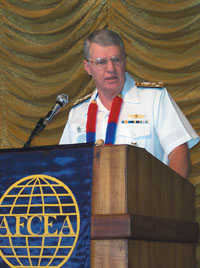 |
| Vice Adm. Gary Roughead, USN, deputy commander of the U.S. Pacific Command (PACOM), gives the opening address at TechNet Asia-Pacific 2004. |
Attendees at the leadoff event heard a candid assessment of the war on terrorism and its ramifications for future military operations from the deputy commander of the U.S. Pacific Command (PACOM). Vice Adm. Gary Roughead, USN, declared that the war on terrorism remains a top priority and noted that terrorists are using information technologies such as cellular telephones to relay messages in their war on the Free World. To win, the United States must be able to communicate and actively share information with its coalition allies.
A key to prevailing in this war will be to anticipate threats and prepare for them rather than react to them, Adm. Roughead stated. This will require the best information technology possible. “Show us the art of the possible with technology and innovative thinking,” the admiral challenged the audience.
Adm. Roughead turned more than a few heads when he declared that the term command, control, communications and computers (C4) was “obsolete.” Instead, the concept should be broken down into “C2 [command and control] plus C2 [communications and computers] plus I [intelligence].” He explained that the first C2 involves organization and structure, which must drive the second C2, which concerns systems. Stovepipes are a problem when it comes to connecting the two C2s, he added.
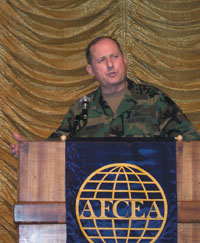 |
| Lt. Gen. John M. Brown III, USA, commander, U.S. Army Pacific, describes the Army’s activities in that vast region in his breakfast address. |
For 34 years, the U.S. Army has not been as involved in continuous combat as it is today, noted Tuesday’s breakfast speaker. Lt. Gen. John M. Brown III, USA, commanding general, U.S. Army Pacific, began that day’s events by observing that these continuous operations represent the first protracted combat for the all-volunteer Army. In addition to the ongoing operations in Southwest Asia, the Asia-Pacific theater possesses a variety of threats ranging from piracy to terrorism and border disputes that threaten to erupt into broader conflicts.
Gen. Brown described how the U.S. Army Pacific is engaged with allies and former adversaries in a variety of activities designed to maintain and promote peace in that vast region. These engagements include medical endeavors with Vietnam, with which the United States did not even have diplomatic relations until only a few years ago. India and Japan are committed to staying engaged with the United States, and the general emphasized that these regional engagements should not be ignored just because U.S. forces are in conflict elsewhere.
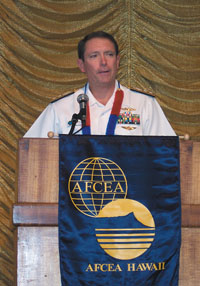 |
| Rear Adm. John J. Donnelly, USN, deputy commander and chief of staff, U.S. Pacific Fleet, tells a packed luncheon audience about the importance of coalition operations in the Asia-Pacific region. |
Because of the breadth of the Asia-Pacific theater, the U.S. Army Pacific must be expeditionary. Gen. Brown stated that it is moving toward that capability through the Army’s new modularity transformation. The new units of action will arrive in theater ready to fight under any command and control. “That’s expeditionary, and it’s within our grasp,” he said.
The network-centric environment around which force transformation is built will move information assurance to the top of the menu. The Army is “only in the infancy of the challenges we will have to face here,” the general declared. No longer will information assurance be the responsibility of signal officers, he added. Now, it is the commander’s responsibility.
Tuesday’s luncheon speaker focused on the aspects of coalition warfare particular to the Asia-Pacific region. Rear Adm. John J. Donnelly, USN, deputy commander and chief of staff, U.S. Pacific Fleet, told an overflow audience that coalition warfare is an increasingly important aspect of the Pacific Fleet. He cited several examples of activities and technologies that are bringing that capability to the fore, especially in the expeditionary arena.
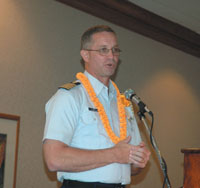 |
| Rear Adm. (Sel.) Craig E. Bone, USCG, chief of staff, 14th Coast Guard District, elaborates on the diverse challenges facing his service. |
A common operational picture synchronization tool allows the combatant commander to manage from a common operational picture shared by fellow commanders and the joint task force. Last year, a roll-on/roll-off communications package aboard an Air Force C-17 cargo aircraft gave personnel aboard the aircraft the use of two 64-kilobit integrated services digital network (ISDN) channels while in flight.
Adm. Donnelly cited the Centrixs system as an important contributor to improved coalition interoperability at the Secret level. The Centrixs-J system has a built-in Japanese language translator that enabled Japan’s minister of defense to communicate from his headquarters to a ship at sea.
Addressing the need for a maritime equivalent of the North American Aerospace Defense Command, or NORAD, Adm. Donnelly called for the same situational awareness that exists in the air. Regional maritime security systems can help tie countries together for tracking ships across the seas.
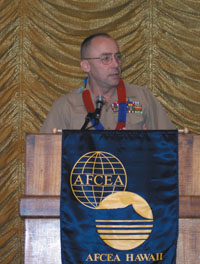 |
| Lt. Gen. Wallace C. Gregson, USMC, commander, Marine Forces Pacific, explains how both political concerns and technological influences play key roles in the war on terrorism. |
“You don’t start a football game by giving the other team the ball on your goal line with four shots to score,” he analogized. That pre-9/11 approach must be replaced by one that begins port security thousands of miles from U.S. shores. And, the key to that is to have a common operational picture with the intelligence community, the U.S. Department of Homeland Security, the U.S. Defense Department and the law enforcement community.
That is being achieved currently to some degree, but Adm. Bone called for a collective picture of shipping as a foundation of an effective layered maritime defense. Data from elements such as satellites, sensors and other tactical assets must be combined with local input. The challenge, he offered, is to bring this information together, especially with legacy systems playing essential roles.
Industry holds the key to achieving this goal, the admiral declared. The private sector can offer the ways and means to implement these ideas. And, it has the ear of Congress, which will play a role in enabling the development of this maritime awareness system.
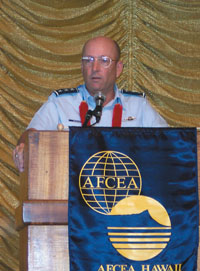 |
| Lt. Gen. Victor E. Renuart Jr., USAF, vice commander, Pacific Air Forces, discusses some of the needs for coalition integration. |
Gen. Gregson noted that the Free World is fighting a war that has been enabled by computer and communications technologies. Not only have allied forces relied on advanced information technologies, so too have terrorist adversaries. Fighting these terrorists will require more than just technology-driven activities, the general offered. The art of warfare has changed to the point where it now is much more akin to violent politics waged on the most vulnerable for shock effect.
The terrorist threat did not develop overnight or because of just one man. Terrorists set up madrassas—religious schools—along with medical care facilities and the charities to fund them. Emphasizing that a terrorist is recruited by an organization, not by a person, the general noted that the average terrorist recruit is a teenager or young adult, often a second son who cannot inherit his father’s mantle, who tends to be immature and has no girlfriend nor career prospect. People at his mosque may see that he is anxious and depressed, so they recruit him as a suicide murderer.
The United States and its allies must take steps to prevent the conditions that provide a fertile recruiting ground for these disaffected youth, the general posited. “We have a distinct interest in any area of the world that descends into chaos and where the writ of government does not run,” he stated.
Allied forces must go after the enemy at its most vulnerable point—these agovernmental base areas. Activities must be aimed at helping governments reassert their authority over these base areas. Coalition operations must be a team sport with allies, friends, coalitions of the willing and friends from a trouble spot, Gen. Gregson continued.
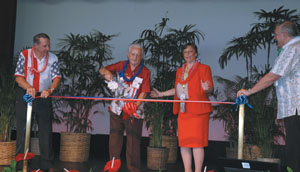 |
| AFCEA International President and Chief Executive Officer Vice Adm. Herbert A. Browne, USN (Ret.) (l), assists Frank Carvalho (2nd from l), an original member of the AFCEA Hawaii Chapter, cut the ribbon opening the exhibit area of TechNet Asia-Pacific 2004. Also assisting are Chapter President Nora Feuerstein and AFCEA Chairman of the Board Eugene C. Renzi, president, Defense Systems Group, ManTech. |
Lt. Gen. Victor E. Renuart Jr., USAF, vice commander, Pacific Air Forces, also emphasized the importance of coalition integration. Speaking at the Wednesday luncheon, Gen. Renuart related how experts 10 years ago believed that Korea would be the major conflict facing U.S. forces. Now, challenges are broader and less symmetrical. “The enemy hasn’t signed up for the law of land conflict,” the general stated.
U.S. forces must continue to pay attention to Korea, but they also must focus on China and Taiwan. More than 60 percent of the world’s oil passes through a maritime region that also is known for piracy and drug trafficking. This diversity of challenges brings with it the need for integrating the diversity of action into operations, including coalition participation.
Saying that the United States will be fighting in coalitions for the foreseeable future, Gen. Renuart cited the need for integrating the diverse players in the region into a coalition, and particularly into the U.S. C2 capability. When this is achieved, an important element would be to ensure a high level of confidence in the information given to coalition leaders.
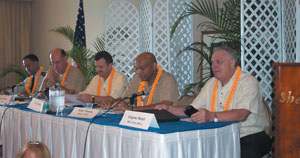 |
| Panel moderator Renzi (r) leads panelists (2nd from r to l) Brig. Gen. John R. Thomas, USMC; Lou Addeo, AT&T; Col. Kevin Jordan, USMC, PACOM; and Brig. Gen. Dennis L. Via, USA, DISA, in a discussion of command, control, communications and computer requirements for combatant commanders in coalition warfare. |
Information must flow from planners and commanders and controllers to forces in battle, and that mandates more efficient use of bandwidth. The general called for conservation of bandwidth without large investments, and this will require better use of existing systems. Gen. Renuart noted that the Pacific Air Forces are 18 months to two years away from having a network-centric air operations center. Classification filters are a major challenge, and implementing Link-16 is a funding challenge, he added.
The event’s first panel tackled the topic of C4 requirements for combatant commanders in coalition warfare. Panel moderator Eugene C. Renzi, president, Defense Systems Group, ManTech, and chairman of the AFCEA International Board of Directors, led the discussion by emphasizing that homeland security itself is coalition warfare. In the United States alone, more than 50 different department heads need the communications necessary to get the job done. That requirement extends down to the person in the field for whom communications are vital to perform his or her duties.
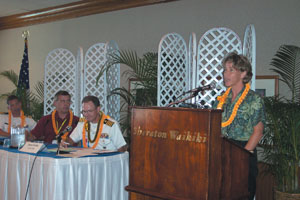 |
| Ainslie Mackovjak of PACOM (r) discusses multinational C4ISR interoperability with panelists (l to r) Cmdr. Kevin Stenstrom, USN, PACOM; Michael J. Maxwell, Maritime Forces Pacific, Canada Department of National Defence; and moderator Capt. James Fordice, USN, PACOM. |
For coalition operations, each member must be part of the Global Information Grid (GIG), the general offered. In addition, he warned that the United States is not making the necessary information technology investments in the coalition arena. Issues that need to be dealt with for combined operations include shared plans and processes; shared battlespace perspectives, as achieving a common operational picture is especially tough for coalitions; and more efficient information security—“permission given, access granted.”
Lou Addeo, president of AT&T Government Solutions, noted that while interoperability might enable connectivity, the performance of that connectivity may be insufficient. Comparing how his company has structured its network, he called for layering communications assets as a key element of convergence. The Defense Department can transform through convergence in the same manner practiced by commercial telecommunications companies. However, that defense convergence must be built-in, Addeo said. The department should adopt commercial practices and models to adapt its networks into a convergence model.
As networks continue to expand, their complexity makes it more difficult for planners to implement them down to lower levels, stated Col. Kevin Jordan, USMC, PACOM J-63. He warned that the military is “betting our lives” on architectures with no overall plan nor overriding purpose. In fact, the biggest threat to the network may be a nonintrusive assault that simply causes the network to collapse of its own weight. He called for training to banish complexities and chance, and added that setting up networks weeks in advance ensures success. “Chance is the blade by which nature mows down inefficiency,” he analogized. “War is natural selection on steroids.”
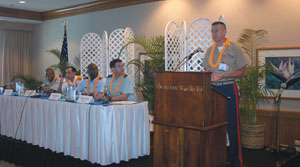 |
| Participants at the panel discussing support to the coalition warfighter (l to r) Col. Gil Griffin, USA, DISA-Pacific; Capt. Dean Kiyohara, USN, U.S. Pacific Fleet; Col. Greg Brundidge, USAF, Pacific Air Forces; and moderator Brig. Gen. Randy Strong, USA, PACOM, listen to a presentation by Col. Bill Febuary (standing), USMC, Marine Forces Pacific. |
During a lively question-and-answer session with the audience, Maj. Gen. David Bryan, USA (Ret.), former PACOM J-6 and former vice director of DISA, weighed in with his views on information technology acquisition. He warned that the military is “stuck in the Cold War” with functionally stovepiped requests for proposals and requests for information. “We need to gang up on the acquisition policy and process czars,” he said.
The event’s second panel covered multinational C4ISR interoperability, and it was moderated by Capt. James Fordice, USN, chief, strategy and integration division, PACOM J-62. Capt. Fordice described the need for information technology interoperability standards such as those employed by NATO for procedures. He also called for the creation of an interoperability guide for use by C4 planners. The captain noted that in some instances the United States’ systems can interoperate with Japanese and Korean equipment, but interoperability between Korea’s and Japan’s systems is not always possible.
Capt. Fordice cited the multinational combined interoperability program, which also was the topic of discussion by Cmdr. Kevin Stenstrom, USN, chief of the combined interoperability coordination branch at PACOM. Nations participating in PACOM’s efforts include Japan, Singapore, Australia, New Zealand, Thailand, Malaysia, Philippines and Korea. The C4I interoperability effort includes standards integration, configuration management, combined interoperability testing, and review of exercises and operations. The captain added that C2 interoperability boards work with each country to make certain that they implement standards that will ensure interoperability with U.S. systems.
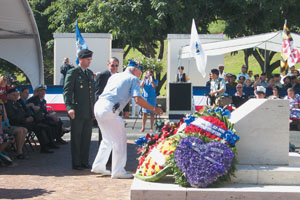 |
| Gen. Strong (l) and Adm. Browne (c) are assisted by a volunteer as they lay a wreath in honor of U.S. veterans during the official Veterans Day commemoration service at the National Military Cemetery of the Pacific in the Punchbowl on Oahu. |
The Canadian perspective was offered by Michael J. Maxwell, deputy N-6, Maritime Forces Pacific, Canadian Department of National Defence. Maxwell related how Canada and its allies are scrambling to keep up with interoperability in network-centric operations. Canada is participating in joint exercises, research and development, and technology demonstrations and evaluations, but work remains in getting operators out to the field to view new technologies. Among the challenges are allied synchronization with national products and information assurance and information security.
Supporting the coalition warfighter was the topic of the event’s final panel, and this panel was moderated by Brig. Gen. Randy Strong, USA, director for command, control, communications and computer systems, J-6, PACOM. Gen. Strong opened the panel with a candid assessment of coalition networks—“We don’t do them well, and we don’t have [a clear view] of where we want to go.” Gen. Strong offered that one reason that coalition networking is not going well is that the networks are too separate. “We want one guy at a desk to have access to everything, not a separate network for each domain,” he said, adding that one possible solution might be a thin-client coalition information technology architecture.
Col. Greg Brundidge, USAF, Pacific Air Forces, stated that coalition networks must be accepted as part of the GIG. Air operations depend on having highly effective C4ISR, and there has been considerable system proliferation in this arena. “We can get decision-quality information” to the warfighter, the colonel noted, but while external coalition partners can be added to the recipients list, the information flows only in one direction. He called for industry to research an infostructure solution that fulfills coalition network requirements.
Capt. Dean Kiyohara, USN, U.S. Pacific Fleet N-6, described how the fleet conducts more than 135 exercises each year with many nations. He added that the Centrixs system is important especially for the flexibility it provides. Describing it as the key enabler for coalition network-centricity, Capt. Kiyohara said that Centrixs is a network infrastructure with core services that is a good start to a true network-centric environment.
Centrixs also was a discussion topic of Col. Gil Griffin’s, USA, commander, DISA-Pacific. Col. Griffin expanded on some of the activities that DISA-Pacific is working on to bring Australia, Japan, the United Kingdom, Canada and New Zealand into Asia-Pacific network-centric operations. Some of these projects seek to expand current capabilities, while others are exploring entirely new concepts.
Photography by Robert K. Ackerman and Estelle Ishimaru.



